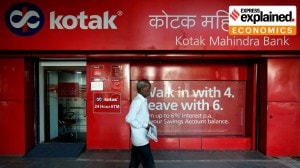- India
- International
UPSC Essentials: Weekly news express — PGII to POEM
A news-laden week comes to an end. Check out the essential weekly news, categorised as per the UPSC syllabus and consolidate your CSE preparation.
 Essential weekly news categorised as per UPSC syllabus. (Representative image)
Essential weekly news categorised as per UPSC syllabus. (Representative image)The Indian Express’ UPSC weekly news express covers some of the most important topics of current affairs news from this week to help you prepare for UPSC-CSE.
Syllabus:
Preliminary Examination: Current events of national and international importance
Mains Examination: General Studies III: Achievements of Indians in science and technology; indigenization of technology and developing new technology.
Why in news?
— Besides placing three Singaporean satellites in precise orbit, the Indian Space Research Organisation (ISRO) on Thursday also achieved the feat of successfully launching the PSLV Orbital Experimental Module or ‘POEM’.
Key takeaways
— The PSLV Orbital Experimental Module (POEM) is a platform that will help perform in-orbit experiments using the final, and otherwise discarded, stage of ISRO’s workhorse rocket, the Polar Satellite Launch Vehicle (PSLV).
— The PSLV is a four-stage rocket where the first three spent stages fall back into the ocean, and the final stage (PS4) after launching the satellite into orbit — ends up as space junk.

— “It is the first time that the PS4 stage would orbit the earth as a stabilised platform,” ISRO said in a statement prior to the launch.
— POEM is carrying six payloads, including two from Indian space start-ups Digantara and Dhruva Space.
— According to ISRO, POEM has a dedicated Navigation Guidance and Control (NGC) system for attitude stabilisation, which stands for controlling the orientation of any aerospace vehicle within permitted limits. The NGC will act as the platform’s brain to stabilize it with specified accuracy.
— POEM will derive its power from solar panels mounted around the PS4 tank, and a Li-Ion battery. It will navigate using four sun sensors, a magnetometer, gyros and NavIC.
— “It carries dedicated control thrusters using Helium gas storage. It is enabled with a telecommand feature,” ISRO said.
Point to ponder: Has ISRO repurposed and used PS4 rocket junk earlier?
Kerala to seek a modification of Supreme Court’s eco-sensitive zone directive
Why in news?
— The Kerala government on Thursday decided to file a modification petition in the Supreme Court in connection with its June 3 order that said all protected forest tracts and wildlife sanctuaries in the country should have eco-sensitive zones of one kilometer from their boundaries.
Key takeaways
— The Supreme Court in June 2022 directed that every protected forest, national park, and animal sanctuary in the country must have a one-kilometer eco-sensitive zone (ESZ) starting from its delimited boundaries.
— According to a three-judge Supreme Court bench, mining and other activities have been destroying the country’s natural resources for years. Until the law makes a final judgement regarding the buffer zone’s dimensions, the court’s order to keep the one-kilometer safety zone will be in effect.
— The court further mandated that each state and territory create a list of all buildings that are currently located within an ESZ and submit reports to the supreme court within three months.
— Farmers in Kerala are worried about losing their prospects for a living in the affected areas. Due to the extremely dense human settlement in these areas, farmer’s groups and political parties have demanded that all human settlements be exempted from the ESZ judgement.
— As Kerala has 24 wildlife sanctuaries, the proposal for having one-kilometre buffer zones from the boundaries of protected forests has raised concern among lakhs of people living within such areas.
— An eco-sensitive zone is a delicate territory that lies within 10 kilometres of protected areas, such as national parks and wildlife sanctuaries.
— One protected region to the next may have a different ESZ width and regulation style. However, the ESZ’s perimeter around the protected area might typically be up to 10 kilometres broad.
— To function as a shock absorber for the protected areas, an Eco-Sensitive Zone will be created. The Ministry of Environment, Forests and Climate Change (MoEF&CC) declares an ESZ around protected areas in accordance with the Environment (Protection) Act of 1986.
Point to ponder: What is the significance of ESZ? What are the activities prohibited under ESZ?
Syllabus:
Preliminary Examination: Indian Polity and Governance-Constitution, Political System, Panchayati Raj, Public Policy, Rights Issues, etc.
Mains Examination: General Studies II: Parliament and State legislatures — structure, functioning, conduct of business, powers and privileges and issues arising out of these.
Why in news?
— Sealing the fate of Maharashtra Chief Minister Uddhav Thackeray and his ruling Maha Vikas Aghadi coalition, the Supreme Court Wednesday declined to stay the floor test that Governor Bhagat Singh Koshyari had asked Uddhav to take Thursday to prove his majority.
— Shortly after the Supreme Court decision, Uddhav resigned as Chief Minister, bringing to an end the MVA rule.
Key takeaways
— A floor test is a motion through which the government seeks to know whether it still enjoys the confidence of the legislature. A Chief Minister appointed by the Governor can be asked to prove majority on the floor of the Legislative Assembly of the state.
— When the House is in session, it is the Speaker who can call for a floor test. When the Assembly is not in session, the Governor’s residuary powers under Article 163 allow him to call for a floor test.
— In the S R Bommai case (1994), the SC held that the floor test is the ultimate test for determining the question of majority of a government in the assembly and thus its legitimacy
— In 2020, the Supreme Court, in Shivraj Singh Chouhan & Ors versus Speaker, Madhya Pradesh Legislative Assembly & Ors, upheld the powers of the Speaker to call for a floor test if there is a prima facie view that the government has lost its majority.
— “The Governor is not denuded of the power to order a floor test where on the basis of the material available to the Governor it becomes evident that the issue as to whether the government commands the confidence of the House requires to be assessed on the basis of a floor test.”
Relevant Constitutional provisions related to the news:
1) Art 154. Executive power of State -The executive power of the State shall be vested in the Governor and shall be exercised by him either directly or through officers subordinate to him in accordance with this Constitution.
2) Art163. Council of Ministers to aid and advise Governor- There shall be a council of Ministers with the Chief Minister at the head to aid and advise the Governor in the exercise of his functions, except in so far as he is by or under this constitution required to exercise his functions or any of them in his discretion.
3) Art 164(1). The Chief Minister is appointed by the Governor and other Ministers are appointed by the Governor on the advice of the Chief Minister.
Point to ponder: What is the difference between a no-confidence motion and trust vote?
Primary agricultural credit societies
Syllabus:
Preliminary Examination: Economic and Social Development-Sustainable Development, Poverty, Inclusion, Demographics, Social Sector Initiatives, etc.
Mains Examination: General Studies III: Indian Economy and issues relating to planning, mobilization, of resources, growth, development and employment.
Why in news?
—The Cabinet Committee on Economic Affairs chaired by Prime Minister Narendra Modi on Wednesday approved computerisation of Primary Agricultural Credit Societies (PACS) with the aim of increasing the efficiency of PACS, bringing transparency and accountability to their operations.
Key takeaways:
—The Primary Agricultural Cooperative credit societies (PACS) constitute the lowest tier of the three-tier short-term cooperative credit (STCC) in India comprising of nearly 13 crore farmers as its members. The other two tiers are State Cooperative Banks (StCB) and District Central Cooperative Banks (DCCB).
—Simply put, it is a village-level institution that directly deals with rural residents. It encourages agriculturists to save, accepts deposits from them, makes loans to deserving borrowers, and collects repayments.
—This project proposes computerization of about 63,000 functional PACS over a period of five years with a total budget outlay of Rs 2,516 crore with the central government’s share of Rs 1,528 crore.
—PACS will become the nodal service delivery point for interest subvention scheme (ISS), PM Fasal Beema Yojana, Direct Benefit Transfer and provision of inputs like fertilisers, seeds etc. It will ensure speedy disposal of loans, lower transition cost, faster audit and reduction in imbalances in payments and accounting with SCBs and DCBs,” the Ministry of Cooperation statement said.
—The project comprises of development of a cloud-based common software with cyber security and data storage, providing hardware support to the PACS, digitization of existing records including maintenance support and training.
Point to ponder: How will the computerization of PACS benefit the agricultural societies?
Jump in demand for NREGS: 2.6 cr families covered in May
Syllabus:
Preliminary Examination: Economic and Social Development
Main Examination: General Studies II: Welfare schemes for vulnerable sections of the population by the Centre and States and the performance of these schemes
Why in news?
—After a dip in April, the demand for work under Mahatma Gandhi National Rural Employment Guarantee Scheme (MG-NREGS) has again seen a rise. According to an analysis of official data, 39 lakh more families availed the rural job guarantee programme across the country in May this year as compared to the same month last year.
—The data, obtained from the NREGA portal, shows that 2.61 crore households worked under the scheme in May 2022, which is 39 lakh – or 17.39 per cent – higher than 2.22 crore in the corresponding month of last year.
Key takeaways:
— Under NREGS, every rural household, whose adult members volunteer to do unskilled manual work, is entitled to get at least 100 days of wage employment in a financial year.
— The Mahatma Gandhi National Rural Employment Guarantee Act (MGNREGA) has the following objectives: provide 100 days of guaranteed wage employment to rural unskilled labour, increase economic security, decrease migration of labour from rural to urban areas.
—Uttar Pradesh saw the maximum increase in terms of the absolute increase in the number of families availing the NREGS.
—The maximum decline of 9.10 lakh was recorded in Chhattisgarh where 6.78 lakh households worked under the NREGS as against 15.89 lakh during the same month last year.
— As on June 25, 2022, 3.62 crore families availed the NREGS during the current financial year 2022-23. In the financial year 2021-22, 7.26 crore families had worked under the scheme.
Point to ponder: In what way paradigm shift has taken place with the implementation of MGNREGA?
Syllabus:
Preliminary Examination: Current events of national and international importance
Mains Examination: General Studies III: Awareness in the fields of IT, Space, Computers, robotics, nano-technology, bio-technology and issues relating to intellectual property rights.
Why in news?
— NASA’s CAPSTONE mission has successfully launched on Rocket Lab’s Electron rocket at 5.55 AM EDT (3.25 PM IST) on June 28.
Key takeaways:
—The CAPSTONE mission will carry a dedicated payload flight computer and radio that will perform calculations to determine where the CubeSat is in its orbital path. The CubeSat satellite will use NASA’s Lunar Reconnaissance Orbiter (LRO) as a reference point to understand its position in space.
—CAPSTONE will communicate directly with LRO and utilise the data from this crosslink to measure how far it is from LRO and how fast the distance between the two changes. This will tell the CubeSat its position in space relative to LRO.
—During the mission, this information will be used to evaluate CAPS (Cislunar Autonomous Positioning System), CAPSTONE’s autonomous navigation software. If tested successfully, the software will allow future spacecraft to determine their location without having to rely exclusively on Earth-based tracking.
—If this software becomes viable, future space missions could perform without support from the ground. This would allow Earth-based antennae to prioritise important science data over routine operational tracking.
Point to ponder: List down major space missions of NASA and other space agencies in news?
Niti Aayog’s report on India’s gig economy
Syllabus:
Preliminary Examination: Economic and Social Development
Main Examination: General Studies III: Inclusive growth and issues arising from it.
Why in news?
— Government think-tank Niti Aayog has proposed fiscal incentives, like tax breaks or startup grants, for companies with about one-third of their workforce as women and people with disabilities. This is in an attempt to increase the participation of women in the gig economy.
Key takeaways:
—Gig economy is based on flexible, temporary, or freelance jobs, is called gig economy. It may involve connecting with clients or customers through an online platform.
—Gig workers are typically hired by companies on a contractual basis and are not considered their employees. As a result, they do not receive some of the benefits that an on roll employee of the company may have — this means that they often do not receive benefits like paid sick and casual leaves, travel and housing allowances, and provident fund savings, among other things.
—Gig workers can be broadly classified into platform and non-platform workers. Platform workers are those whose work is based on online software apps or digital platforms. Example: those whose work is based on online software apps or digital platforms such as food aggregator platforms Zomato, Swiggy, Ola, and others.
—Non-platform gig workers are generally casual wage workers, working part-time or full- time.
—The report estimates that more than 7.5 million workers were engaged in the gig economy in 2020-21. This could grow to 23.5 million workers in the next eight years, making up for 4.1 per cent of total livelihood in India.
—According to the report, at present about 47 per cent of the gig work is in medium skilled jobs, about 22 per cent in high skilled, and about 31 per cent in low skilled jobs. Gig workers can be broadly classified into platform and non-platform workers.
—According to the report, the challenges of the gig economy sector are- lack of job security, irregularity of wages, uncertain employment status for workers etc. As independent contractors, platform workers cannot access many of the workplace protections and entitlements.
— A survey conducted across urban centres of India revealed that women are more likely to take up platform jobs after their education and marriage.
— Female labour force participation in India has remained low, oscillating between 16 per cent to 23 per cent in the last few years.
— Persons with disabilities, who make up 2.11 to 10 per cent of India’s population, have a labour force participation rate of 36 per cent.
— Structural barriers like access to education and lack of skilling have hindered the participation of the two demographic groups in the country’s labour force.
— Fiscal incentives such as tax-breaks or startup grants may be provided for businesses that provide livelihood opportunities where women constitute a substantial portion (say, 30 per cent) of their workers. Likewise, a platform with high accessibility or high degree of participation of PwDs too may be rewarded with fiscal incentives.
— Apart from incentivising platforms that focus on recruiting women workers, the report also recommended that businesses have a higher share of women managers and supervisors in the organisation to ensure that communication to workers does not perpetuate gender stereotypes.
— However, according to the report, platform companies offer flexibility and choice of labour to all workers in general, and women in particular, empowering them to monetise their idle assets when and where they want — a benefit missing in traditional employment sectors — making them an attractive opportunity for women and persons with disabilities.
— The report suggests that companies carry out gender sensitisation and accessibility awareness programmes for workers and their families, particularly to promote the rights of women and persons with disabilities. It also suggests partnering with various stakeholders to upskill women and disabled persons.
—The report also recommended that firms adopt policies that offer old age or retirement plans and benefits and other insurance cover for contingencies such as injury arising from work that may lead to loss of employment and income.
—Such plans and policies may be uniquely designed by a firm, in partnership with insurance companies, or could be designed and offered in collaboration with the government, as envisaged under the Code on Social Security, 2020. A social security cover out of a corpus fund can also help gig workers in case of contingencies, it said.
—The report said businesses should consider providing income support to workers as it would be a “critical step in providing assured minimum earnings and social security from income loss in the wake of uncertainty or irregularity in work”.
—It also suggests offering paid sick leave to workers apart from insurance cover.
—Access to institutional credit could be enhanced through financial products specifically designed for platform workers and those interested in set up their own platforms.
—Financial technology companies can be leveraged to provide cash flow-based loans to workers as against collateral-based loans, thereby catering to the needs of those new to credit. Special emphasis may be placed on access to formal credit for women and persons with disabilities.
Point to ponder: With the “platformization” of work, India requires a framework that balances the flexibility offered by platform firms while also ensuring the social security of workers. Discuss.
Syllabus:
Preliminary Examination: Current events of national and international importance.
Mains Examination: General Studies II: Bilateral, regional and global groupings and agreements involving India and/or affecting India’s Interests.
Why in news?
—The G7’s infrastructure investment plan to counter China’s Belt and Road Initiative
Key takeaways:
—The G7 is an informal forum of leading industrialised nations, which include Canada, France, Germany, Italy, Japan, the United Kingdom and the United States. Representatives of the European Union are always present at the annual meeting of the heads of state and government of the G7. Germany holds the presidency of the G7 in 2022.
—The G7 countries, which are meeting during the ongoing Leaders’ Summit in Germany, have officially launched the Partnership for Global Infrastructure and Investment (PGII), a joint initiative to fund infrastructure projects in developing countries. The project, launched on June 27, is being seen as the bloc’s counter to China’s ‘Belt and Road Initiative. US President Joe Biden said on Twitter, “Collectively, we aim to mobilise nearly $600 billion from the G7 by 2027 to invest in critical infrastructure that improves lives and delivers real gains for all of our people.”
Point to ponder: What have been the key takeaways of G7 2022 for India?
Apr 24: Latest News
- 01
- 02
- 03
- 04
- 05







































